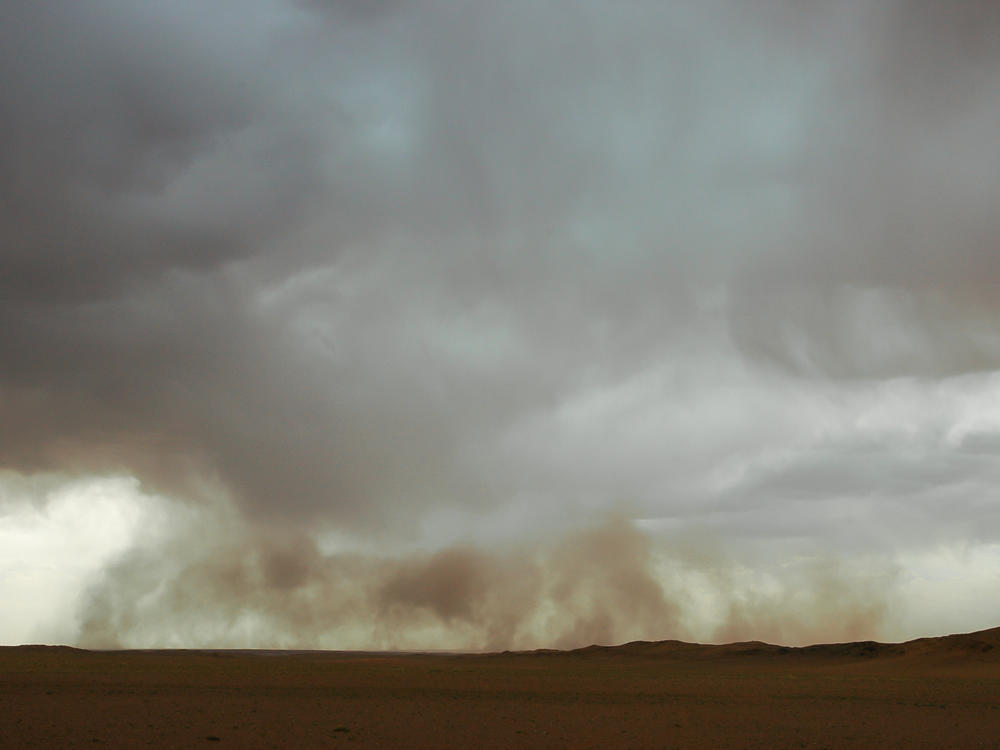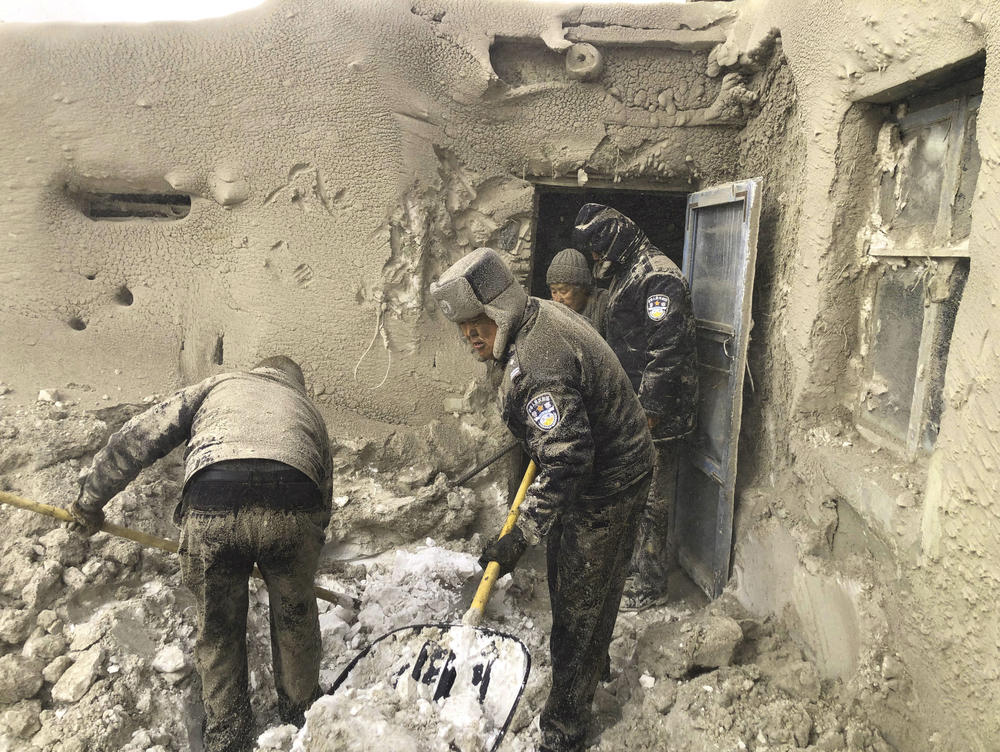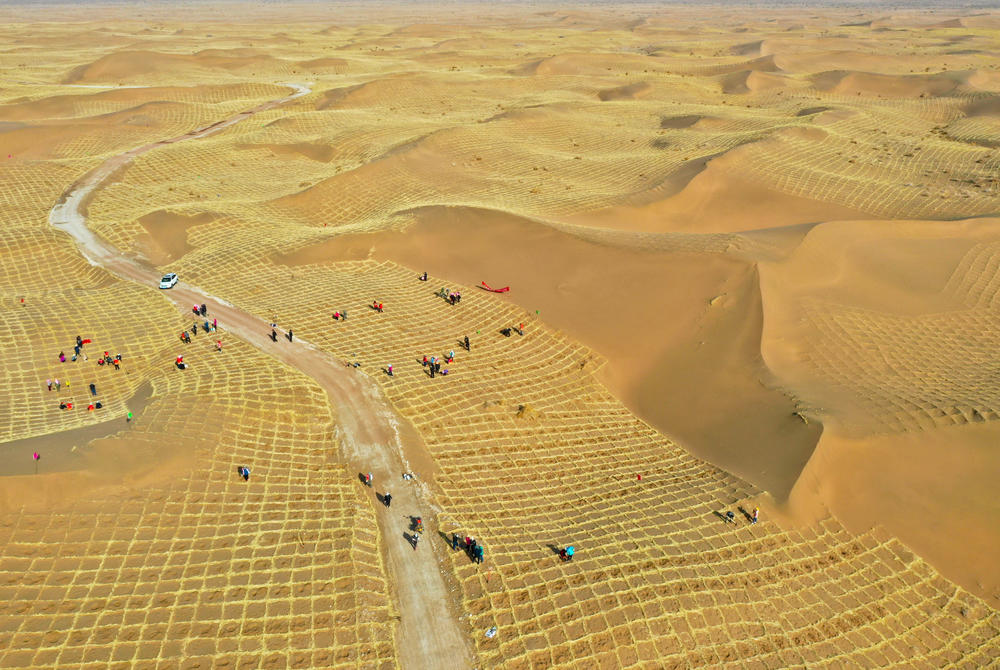Section Branding
Header Content
Buried Alive In Mongolia's Worst Sandstorms In A Decade
Primary Content
ULAANBATAR, Mongolia – This March, as Mongolian herder Batsaikhan Enkhee tended to his sheep, the sky suddenly darkened. The wind picked up, filling his shoes and shirt with coarse, heavy sand. A massive sandstorm had engulfed the Mongolian grasslands.
"It was dark like the night," Batsaikhanm, 53, told NPR. "I thought I would die."
The herder huddled with his sheep as airborne dirt blocked out the sun. His brother found him the next day, buried in the sand, and dug him out. He survived, but 200 of his sheep died in the storm, about one-fifth of his herd.
Sheep weren't the only casualty. Nine Mongolian herders perished on the steppes in what has been the worst sandstorm season in both Mongolia and China in a decade.
The cloud of sand then blew its way over the course of the next day into Beijing, more than 600 miles away. There, the sky suddenly turned a garish yellow. The air quickly filled with plumes of coarse grit, basting cars and balconies a dusty brown.
Beijing has historically been beset by springtime gales bringing sand in from the Gobi, a vast swath of desert and craggy rock that runs between China and Mongolia. Decades of reforestation efforts along China's northern border had reduced the sandstorm frequency.
Until this year.
A combination of extreme weather, climate change and environmental degradation have created the perfect storm – or rather, a series of eight cross-border sandstorms through March, April and May that have destroyed animal herds, exacerbated respiratory problems and cancelled flights in both Mongolia and China. The news video below captures the magnitude of this year's storms.
The result has been catastrophic in Chinese and Mongolian regions bordering the Gobi. In northern China, tourists found themselves trapped by pelting wind. Air pollution levels skyrocketed to more than 20 times the healthy limit. Southern Mongolia was hit particularly hard; successive sandstorms have killed an estimated 1.6 million livestock, which many herders depend on for income.
"Even the rescue teams could not even go forward because it was so dark during the [March] storm," says Jargalsaikhan Sonomdash, the governor of the southern Mongolian county of Airag, where 3,600 animals died after they were buried by sand drifts.
Mongolian climate experts say an unusually dry year for precipitation created huge amounts of loose sand. "Almost no snow fell last winter, and some provinces had no rain last summer," says Dulamsuren Daskhuu, a senior researcher at Mongolia's Meteorology and Environmental Monitoring Research Institute, a ministry.
The Gobi desert is also growing bigger. Desertification is creeping up into northern Mongolia at an average rate of 75 miles a year, according to Dulamsuren's institute.Part of the reason is climate change.
Temperatures in Mongolia have increased about 4 degrees Fahrenheit in the last 70 years, according to the Mongolian Ministry of Environment, about twice the rate of the recorded global average increase.
Pollution from widespread mining of gold, coal, and copper has also speeded up desertification. It's stripped vegetation and led lakes and streams to dry up.
Another big factor in promoting sandstorms is overgrazing. The number of Mongolian livestock animals has nearly tripled in the last 30 years, according toMongolia's national statistics office. The number of goats has grown the fastest, from 5 million heads to 27 million heads. Mongolian goats produce an estimated 40% of the world's cashmere. They also eat twice the amount of grass that sheep do, destroying pastureland at an unsustainable rate.
"If no measures are taken now, Mongolian will be all desert in 30 to 40 years," says Dulamsuren. "There will be many more sandstorms in the future."
Not all the sand is coming from Mongolia however. Satellite imagery show that the sandstorms that coated China later in the spring season, during April and May, largely originated from northern Chinese provinces like Ningxia, Gansu and Inner Mongolia. This winter, the average ground temperature there also remained 10 to 15 degrees Fahrenheit higher than usual, says Liu Junyan, a Beijing-based researcher at Greenpeace. That caused faster evaporation, less water retention, and more dry sand.
"China's northwestern and northern areas always experience annual sandstorms as a natural phenomenon," says Liu. "Just because people did not pay attention to the storms does not mean the storms stopped existing."
In March, the extra sand was then picked up by seasonal winds given an extra boost by La Nina, a cyclical weather phenomenon where the Pacific Ocean cools and which can also lead to an uptick in hurricanes and less rainfall.
Since 1978, China has had a sandstorm battle plan, planting an estimated 66 billion trees along the country's border with Gobi Desert – a phalanx of vegetation nicknamed "the Great Green Wall." It is intended to anchor loose dirt and prevent small sandstorms from picking up speed. But such was force of this year's storms that loose sand was propelled hundreds of yards up into the air, hurling it well above the line of trees meant to hold back such incursions.
In China's capital of Beijing, residents huddle indoors each time the air outside becomes too hazardous to breath due to sandstorms. But for those living closer to the Gobi, the increased rate of sandstorms is a matter of life and death.
This past March, as dust ominously began to cloud the skies in Mongolia's southern Dornogovi province, herder Nyamsambuu Myadagmaa, 43, and several other herders shepherded some of their sheep and goats into a barn for safety.
But the sandstorm lasted 20 hours – the longest on record – and dumped so much sand on the barn that its roof caved in, killing the animals inside. Animals that had been left outside were literally buried alive.
"Many of us found our animals that were killed in the steppe because they were stuck in sand and only their ears or head were left poking out," Mydagmaa remembers. The survivors had been blinded by the scouring sand.
Amy Cheng contributed research from Beijing.
Copyright 2021 NPR. To see more, visit https://www.npr.org.




